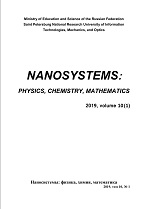|
This article is cited in 1 scientific paper (total in 1 paper)
CHEMISTRY AND MATERIAL SCIENCE
Evaluation of the electrochemical active surface area for carbon felt and nanostructured Ni coatings as electrocatalysts for hydrogen evolution reaction
Dmitry S. Dmitriev, Maksim I. Tenevich
Ioffe Institute, St. Petersburg, Russia
Abstract:
This study is devoted to the evaluation of electrochemical active surface area (ECSA) for carbon felt used in various fields of electrochemical technology. For the evaluation, we used techniques based on Faraday’s law, the Randles–Sevcik equation and the calculation of the electric double layer capacitance in the electrolyte with different pH value. The measurement results are consistent with each other and for neutral, acidic and alkaline medium, the ECSA value are 20 – 30, 30 – 40 and 50 – 90 cm$^2$ per 1 cm$^2$ of geometric surface, respectively. Based on the results, the synthesis of nanostructured nickel coatings on carbon felt with prior electrochemical activation was performed. The pre-treatment in 1M KOH vs 1 M Na$_2$SO$_4$ reduces the crystallite size from 26 to 15 nm and increases the ECSA from 133 to 700 cm$^2$ per 1 cm$^2$ of geometric surface. These changes cause an improvement in other electrocatalytic features for hydrogen evolution reaction. KEYWORDS carbon felt, electrochemical surface area, electrodeposition, voltammetry, double layer capacitance, Randles–Sevcik equation, nickel coating, hydrogen evolution reaction.
Keywords:
carbon felt, electrochemical surface area, electrodeposition, voltammetry, double layer capacitance, Randles–Sevcik equation, nickel coating, hydrogen evolution reaction.
Received: 07.09.2023
Revised: 05.10.2023
Accepted: 07.10.2023
Citation:
Dmitry S. Dmitriev, Maksim I. Tenevich, “Evaluation of the electrochemical active surface area for carbon felt and nanostructured Ni coatings as electrocatalysts for hydrogen evolution reaction”, Nanosystems: Physics, Chemistry, Mathematics, 14:5 (2023), 590–600
Linking options:
https://www.mathnet.ru/eng/nano1226 https://www.mathnet.ru/eng/nano/v14/i5/p590
|

| Statistics & downloads: |
| Abstract page: | 187 | | Full-text PDF : | 88 |
|




 Contact us:
Contact us: Terms of Use
Terms of Use
 Registration to the website
Registration to the website Logotypes
Logotypes








 Citation in format
Citation in format 
